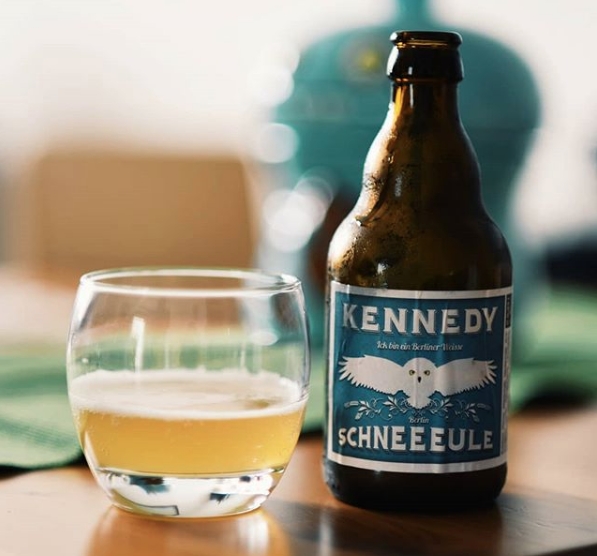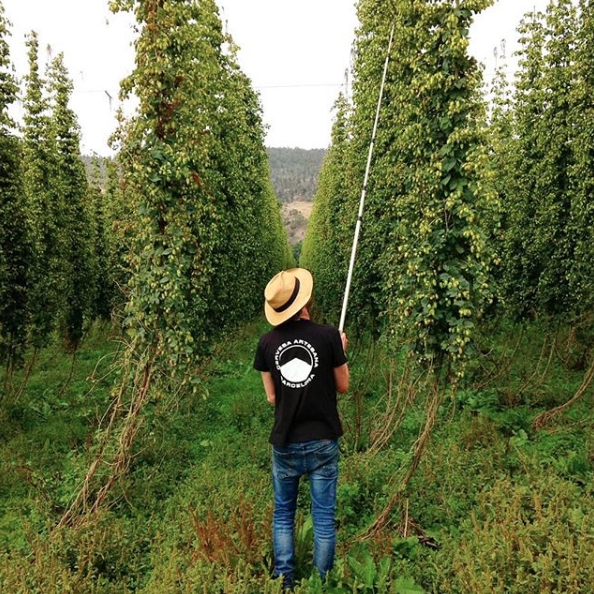
Getting into beer is a rollicking good time. For one, you get to drink tasty brews as “research.” That’s always fun. Along the way, you also get to geek out on the process of crafting the beers you love. After all, brewers are, in essence, chemists. And what better way to nerd out on science than in a discipline that leaves you buzzed?
Therein lies a bit of a barrier though. Beer, like most subcultures, has a specific language. That beer-specific vernacular is intimidating. When beer aficionados, brewers, and servers start throwing around terms like “ester” or “diacetyl” or “secondary fermentation,” the average beer drinker isn’t going to know what the hell they’re talking about. But this doesn’t have to be as hard as it seems at first glance. Esters and diacetyl are volatile flavor compounds that lead to fruity/flowery and butterscotch flavors respectively. Secondary fermentation is simply a second fermentation in a sealed container. See? We’re learning already.
To help you break into the world of beer, we thought we’d throw down some basic terms and explain what they mean. This is by no means a comprehensive list of beer-related buzzwords. This is a gateway to the larger beer world. Some basics that invite you to dive deeper. It’s also worth noting that where there’s a rule or definition in beer, there’s almost always an exception. Though that might seem annoying at first, once you get the hang of things it’s sure to be part of the fun.
Malts

Malts are the foundation of beer. This is where you start your flavor journey. Basically, malts are made from barley that’s “malted.” That means, that after the grains are harvested, they are germinated with fresh water until they start to sprout. Then the barley is dried, usually in a kiln, until the germination stops and the starches are converted into edible sugars. It’s in that kilning process that massive, foundational flavor is created for the final product of the beer. For instance, if smoke is being used in the kiln, you’ll end up with a smoked beer.
From there, the malt is milled into a grist. That grist is cooked with water to make a wort. That wort is then sent to a fermenter where yeasts are added to eat those sugars and create alcohol. Hops are added and, more or less, malted barley is now beer.
One last note on malts, while barley is the most commonly used, malted wheat is also super common. Wheat beer (hefeweizen) uses malted wheat in the same way as malted barley. However, the amount of wheat varies. In Germany, to be called a “Hefeweizen,” the beer has to be at least 50 percent wheat (with the rest being barley). Other types vary widely. Wheat malt in Berliner Weisse, for instance, is closer to 30 percent. American wheat beers can be anywhere from ten to 30 percent wheat.
Yeast

Probably the next most important term to know is yeast. Without yeast, there is no alcohol. Yeast is a living organism, a fungus, that is added to the wort to eat sugars and create alcohol. Brewer’s yeasts (Saccharomyces) are a very specific thing to each beer brewed. Belgian lambics are fermented with wild yeasts from the Pajottenland air over the spring and summer. Lagers need “lager yeast” which ferments at colder temperatures and creates that crisp bite those beers have.
This all leads us to…
Ales vs. Lagers

When people talk about an ale or a lager, what they’re really referring to are beers made with either “top-fermenting yeast” versus “bottom-fermenting yeast.” Top-fermenting yeasts are also known as “ale yeasts.” In short, these yeasts like to eat sugars at higher temperatures (sitting at the top of the brew). This yeast also has a little bit harder time fermenting the sugars in the wort, leaving behind a more of a “malty” flavor. That may equate a sweeter, more floral/earthy, or even fruitier nature to the end result.
Bottom-fermenting yeast is a different beast. Commonly called “lager yeast,” it likes to live and eat in colder temperatures. Due to that, it also eats a lot more of the sugars and eventually settles to the bottom of the brew. This means that the brew becomes a lot clearer, crisper, and sharper.
Hops

The last key (non-water) ingredient here is hops. The flower is crucial to flavoring and preserving beer. There’s an incredible amount of variation in how beers — lagers or ales — are hopped and why they’re hopped.
Let’s keep it simple. Hops add bitterness first and foremost. From there, you can dry hop a beer with pellets, wet hop with fresh flowers, or employ some combination of the two methods at every stage of the process, starting at fermentation. Depending on the variety of hops, you can get notes of pine, cannabis resin, mango, pineapple, grass, and so, so much more. More often than not, when you drink a dank or fruity IPA, it’s the hops that are creating that bitter dankness or bright fruitiness.
Adjunct

Okay, we’re getting into a little more specific territory here. Adjunct is a world that’s very important to “macro” beers. That is, the beers most of us drink, by far. Beers made on a major scale (macro) often use “adjuncts” in their wort.
An adjunct is usually corn or rice syrup added after the beer is made. In essence, this makes the beer lighter, sweeter, and easier to drink. Think an ice-cold Corona on a very hot summer day. There’s that clear layer of corn sweetness on the back end there. That’s because Corona uses corn as an adjunct (corn has become an essential flavor associated with “Mexican Lagers”).
While corn and rice adjuncts are often hated on in the craft beer community, there are plenty of examples there too. Craft brewers pride themselves on keeping the base of beer as adjunct free as possible but are not afraid of adding everything from coffee to fresh berries to you name it into the fermenter.
Decoction

Decoction is a method of making beer wherein the malts are heated and cooled up to three times to varying temperatures. It’s mostly only found in German and Czech style lagers, especially Pilsners.
This is a very old-school method of making beer. Basically, the aim here is to draw out more starches. But that’s not all. Decoction also creates a Maillard reaction on the malt. This adds serious depth to the wort. Think about it this way, is your steak better or worse off when you sear it, creating a Maillard reaction? Exactly.
When you get a deeply amber Bohemian pilsner with a strong malt base of sweetness and blooming fields, you can thank decoction.
Reinheitsgebot (“German Purity Law”)

The Bavarian Purity Law doesn’t really apply to any beer outside of Germany. Even in Germany, it’s only followed by the most traditional brewers around the country these days. Still, the 1516 law is a landmark in brewing and is thrown around a lot.
Simply put, the laws states that to be called “beer” a brew must only contain water, malted grain (barley or wheat), yeast, and hops. Add in any other ingredient and it’s no longer a “beer.” So, according to the old world Germans, that cherry-steeped lambic on tap isn’t really beer. Obviously, this definition is too restrictive for the modern beer scene and would limit creativity, but this law helped define what beer is. It gave brewers a chance to dial-in styles in ways that help them endure to this day. (It also killed a lot of regional German styles that are only making a comeback in recent years).
ABV

The ABV is “alcohol by volume.” If you’re going to geek out on beer, you really want to know what the ABV is of the beer you’re drinking. A Berliner Weisse can be as low as three percent. That makes it a very sessionable beer. A “session beer” is one that usually clocks in under five percent. The name derives from being drinkable during a beer-drinking “session,” that is, all day. Guinness, Pilsner Urquell, PBR all fall into this category.
Most lagers and pale ales clock in at around five percent. From there, ABVs can climb into the low teens pretty fast. It’s important to remember that high ABV beers with 10 percent ABV or more are often intended to be sharing beers. Think of it this way, once you hit 12 percent ABV you’re in wine ABV territory.
IBU

IBUs are “International Bitterness Units.” This measures the bitterness in the beer derived from the hops.
Very generally, low IBU beers are wheat or white ales, some lagers, porters and stouts. Also very generally, high IBU beers tend to be pale ales, IPAs, and some pilsners. It’s imperative to remember here that all of this is broad brush strokes and wholly dependent on who’s brewing what. Brewers can 100 percent hop, in any way, a wheat beer and get an IBU count higher than a standard IPA. It’s not common, but it’s also not unheard of. It’s best to keep an open mind here.
Brettanomyces

This is probably the most advanced word on the list. Brettanomyces, or “Brett,” is a specific yeast fungus. It’s most commonly used for fermentation in Belgian-style beers — think lambic, gueuze, farmhouse ales, Flanders red ale, saisons, and so forth.
The rebirth of interest in these Belgian beers has helped herald in a new area of interest in brewers brewing up suds made using the specialty yeast all over the world. And there are a lot of ways to use brett in beer.
Sometimes brett is pitched into the fermenter along with the brewer’s yeast (Saccharomyces). Sometimes brett is inoculated into barrels for secondary fermentation. Sometimes brett completely replaces brewer’s yeast. It just varies.
In the end, fermenting with brett often leads to that sour funk in tart beers. That’s all the rage right now, so expect to see a lot of “brett” style beers on the shelves in the coming years.






